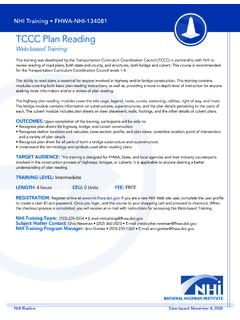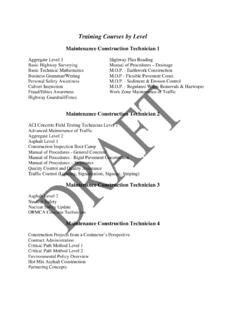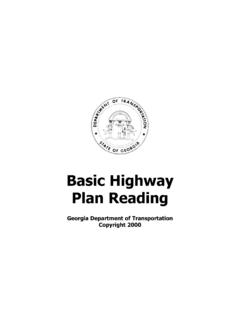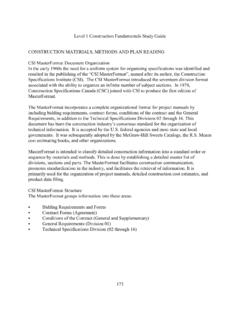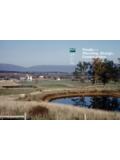Transcription of SURVEYING FOR INSPECTORS Day 1 - oregon.gov
1 SURVEYING FOR INSPECTORSDay 1A Presentation Created by the Virginia Department of Transportation2 Welcome3 INTRODUCTION The purpose of this class is to give you exposure to basic SURVEYING terminology, equipment, tools, and calculations related to the needs of construction inspection. Some of what you will hear in this class will be a repeat of your plan reading course and we will be working with the same set of highway plans used in that class. As an inspector you will be relating and comparing proposed ( plan ) information to horizontal and vertical locations in the field. This will require you to have a thorough understanding of the plans, be able to check survey stakes or actual construction, and determine accuracy relative to the proposed information. As an inspector you will NOT be required to do the surveyor s job. Therefore much of what is taught in a traditional introductory SURVEYING class will not be a concern to us at this By the end of these two days of instruction, you will be expected to have the basic tools needed to accomplish the following: Interpret proposed information from plans.
2 Check field location of survey stakes and actual construction features. Obtain and calculate field measurements. Communicate with contractors/engineers & surveyors/ INSPECTORS . Your goalsto achieve in this class will be: Recognize and be able to use basic survey instruments and equipment. Understand how to read and measure distances. Understand how to read and interpret survey stakes. Prepare legible field notes. Compute and check & DEFINITIONSAs we progress through this class, you will be hearing terms that you may not be familiar with. We will discuss some of them; but included in your hand-out, behind Tab 3, is Appendix A, which is a glossary of terms relevant to SURVEYING for construction projects. You may find this to be a helpful reference as you progress into your distinct types of measurements are utilized by the surveyor to define the relationship of points.
3 Horizontal Distance: distance between two points as measured on a horizontal or level plane. Direction: angles measured in either horizontal or vertical Elevation: vertical difference between two points, relative to a of Measurements English:feet, miles, acres Metric:meter, kilometer, hectares Surveyors use the decimalfoot as opposed to the builder s or architectural standard of 1/16ths. Surveyors tapes, rules, level rods, etc. are based on a foot being divided into ten parts or tenths of a foot ( ). A tenth of a foot is further divided into ten parts or hundredths of a foot ( ). So a measurement is shown as . Angles are measured by degrees, minutes, and secondsbeing shown as 15 20 35 Acreageis measured in square feet. An acre equals 43,560 which is approximately 210 x 210 . MEASUREMENTS9 Accuracy, Precision, and Positional ToleranceThe terms accuracy and precision are often used interchangeably to describe the correctness of a measurement.
4 This is incorrect because these two terms have different meanings. Accuracyrelates to how close a measurement is to the true value. Precisionis a measure of consistency and how close measurements are to each are equally important in the surveyor s field work. Tolerancecan be defined as how much a field measurement or point set in the field can vary from the true angle, distance, or location. Tolerances vary based on the type of work being performed. For example, a tighter or higher tolerance is required for bridge stakeout than the stakeout of a ditch. To determine the level of tolerance, you must consider several factors such as: What is the desired end-product and will a variation impact it s function?For example, a horizontal shift in a culvert alignment does not impact the pavement surface. What material is being used in the construction?
5 For example, a rip-rap lined drainage ditch (low tolerance) versus a concrete bridge abutment (high tolerance). How will the item be constructed, and of what accuracy is the construction equipment capable?For example, a bulldozer has low tolerance (within a few inches), while a curb and gutter machine has a high tolerance (within a quarter of an inch).MEASUREMENTS10 MEASUREMENTS11 Horizontal Angles & Bearings Circle-360 Quadrants- NE SE SW NW Adding & Subtracting angles and bearingsWhat is the angle between Bearing 1 and Bearing 2?N5729 45 ES3025 55 E8754 100 -60= 8755 40 = 17959 60 8755 40 = 9204 20 MEASUREMENTS12(Break- 15 min.)13 Vertical Angles and Slope Distances Vertical anglesare measured by a theodolite ortotal station. Slope distanceis the distance measured along the inclined surface. % of Grade is the degree of inclination from the horizontal, the rise or fall for each 100 feet measured horizontally.
6 * example:3% grade = 3 rise or fall in 100 *from Plane SURVEYING by John C. Tracy, ; Yale University, 1907 MEASUREMENTS14 plan Stationing and Offsets Stationingis used to define distances relative to the alignment of the roadway. 100 foot stations are marked on the horizontal alignment by tick marks at the 100 intervals and full tick marks every 500 . A station is expressed as the 100 station followed by the remaining horizontal distance, ex. (566+ ).MEASUREMENTS15 Station equalitiesare used in cases where it is necessary to relate to another baseline in order to maintain the integrity of the information on both sets of plans. When calculations are performed involving points on either side of an equality, the value of the equality must be taken into consideration. An offsetis given in order to relate points off of the construction baseline.
7 Drainage structures, right-of-way breaks, and any other feature that the surveyor will have to stake in the field is referenced with a station and Stationing on circular curvesrequires some basic understanding of the geometry of TO FIELD EQUIPMENTM orning class was an introduction into the basics that surveyors use in the course of doing their work. We are now going to look at the tools and supplies used on a construction SURVEYING Equipment Probably the most common and well known survey tool is the plumb bob. A plumb bob is used, while taping distances, to project a vertical line from a point on the ground. While it appears to be as basic a tool as there is, skill and experience are required to use a plumb bob accurately and effectively. A Gammon reel is often used for storage of the string line which is attached. A plumb bob should be dried and wiped clean before storing it in its leather BobFIELD EQUIPMENT19 Tapes There are many types and styles of tapes that you may see on a construction project.
8 Most surveyors will have an accurate steel tape for use in setting out stakes. These tapes are usually found in 100 or 200 lengths and require the proper tension for accurate measurements. Fiberglass cloth tapesare common for making measurements where tolerances are low or rough checking distances. These tapes are relatively inexpensive and are easy to carry around a job site. Stick rulesare handy for measuring short distances (under six feet) and fold conveniently to fit in a pocket or pouch. The engineers stick rule is graduated on one side in tenths of a foot while the other side is marked in inches. Care must be taken to be sure you are reading the correct side of the rule. With any measuring tape it is wise to check the graduations, prior to measuring, to assure accurate readings. It is important that tapes are held horizontal while measuring distances.
9 If unable to hold the tape horizontal, a slope angle must be obtained and the horizontal distance calculated. Care should be taken with any tape to keep them clean and in the case of steel tapes, oiled. Tapes should be reeled up and not left out in roads or work areas. Basic SURVEYING Equipment20 Level Rods Level rodsare available in various lengths, shapes, materials, and graduations. They are used for determining relative elevations in combination with auto or hand levels. Probably the most useful on construction projects will be the fiberglass extension rods which are available up to 25 , but retract to 5 . These rods are available in metric and English should be taken to avoid damaging the face of the SURVEYING Equipment21 Tripod A tripod, as its name implies, is a 3-legged unit that is used for the stable set-up of survey instruments and targets.
10 Instruments are locked onto the tripod by a lockdown screw attached to the head. Care should always be taken that the feet are firmly planted in the ground or weighted when set on pavement or concrete. Care should always be taken that the instrument is properly seated and locked onto the tripod. The head of the tripod should be kept clean and protected from damage. Tripods should be dried before storing in a secure and dry location (not thrown in the back of a pick-up truck).Basic SURVEYING Equipment22 Stakes & Nails Wooden stakesare found on any construction project. They are available in various lengths and widths, and are usually cut from pine or oak. The important thing to know about stakes is the labeling or marking that is written on them. This will be discussed in detail tomorrow. Surveyors also will use wooden hubs with tacks, iron rods or pipes, and nails (PK nails) for marking important points on the ground.










